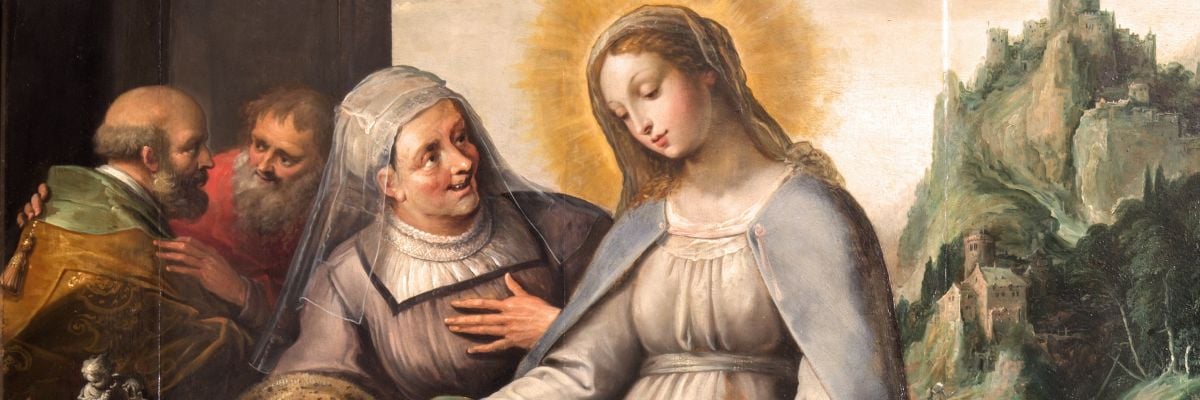
Perhaps the most important truth revealed to us yesterday in the great Feast of the Visitation of our Lady to her older relative Elizabeth, which we find recorded in Luke 1:39-56, is the revelation of Mary as the Mother of God, or Theotokos. Among all of her titles—and there are many—Theotokos is by far the greatest, for in and through it we discover not only the glories of Mary, but more importantly, we find revealed who Jesus is: an eternal and divine person who acquired a human nature in order to redeem all of mankind.
The phrase Mother of God is not in Scripture, but we do have something synonymous here in Luke 1:43, in the heart of the visitation account. When Mary entered Elizabeth’s home and greeted her, Elizabeth “exclaimed with a loud cry: ‘Blessed are you among women, and blessed is the fruit of your womb! And why is this granted me, that the mother of my Lord should come to me?’” The Catechism of the Catholic Church explains:
Called in the Gospels “the mother of Jesus,” Mary is acclaimed by Elizabeth, at the prompting of the Spirit and even before the birth of her son, as “the mother of my Lord.” In fact, the One whom she conceived as man by the Holy Spirit, who truly became her Son according to the flesh, was none other than the Father’s eternal Son, the second person of the Holy Trinity. Hence, the Church confesses that Mary is truly “Mother of God” (Theotokos) (495).
Biblical evidence for this dogma is not limited to the New Testament. St. Cyril of Jerusalem and the fathers of the Council of Ephesus referred to an intriguing prophecy from Isaiah 7:14 in their own exposition of both Jesus’ divinity and Mary’s divine maternity:
For the holy prophet Isaiah does not lie when he says, “Behold a virgin shall conceive and bear a son and they shall call his name Emmanuel, which is interpreted God with us.”
The Messiah was to be born of a woman, and yet he was to be called Immanuel, which means God with us. According to the council fathers, God with us means what it says: Jesus is God; so this prophetic virgin, Mary, would then be the Mother of God. Add to this prophecy the text of Luke 1:43 and we have both the Old and New Testaments revealing the “Catholic” truth about Mary.
“Not so fast,” say many of our Protestant friends. Jimmy Swaggart, in his book Catholicism and Christianity, represents one among a chorus of voices who object to this historical Christian understanding. He presents quite a different take on Luke 1:43:
Here Elizabeth called Jesus “Lord”… But once again it must be emphasized that it was not God that was born of Mary, it was the human child—the Lord Jesus Christ.
To be fair to Swaggart, the New Testament does use the term lord to denote authority figures or even things—e.g., idols that are obviously not the one, true God. In 1 Corinthians 8:5, for example, St. Paul writes, “Indeed there are many gods and many lords.” This would indeed refer to something other than almighty God—a lord, instead of the Lord, if you will.
So, does Jimmy Swaggart have an argument here? Could lord here in Luke 1:43 refer to Jesus’ humanity rather than his divinity?
This is not a point to dismiss lightly. How can we know whether lord (Gr., kurios) refers to divinity or not? As is the case with all of biblical exegesis, context is key, and the above-quoted 1 Corinthians 8:5 provides an excellent example of why. Paul’s words, “Indeed there are many gods and many lords,” are immediately followed by, “Yet to us there is one God, the Father, from whom are all things, and for whom we exist, and one Lord, Jesus Christ, through whom are all things and through whom we exist.”
Both the pagan and Jewish converts in Corinth would have immediately understood Paul’s carefully crafted words. Jesus is the one Lord in contrast to the “many [false] lords” worshipped in the surrounding pagan world. Thus, to these pagan converts, these words could hardly be plainer: Jesus is God. And his Jewish Christian readers would have been familiar with the great sh’mah of Deuteronomy 6:4: “Hear, therefore, O Israel, the Lord our God is one Lord.” When Paul refers to Jesus as the one Lord, his Jewish readers and listeners could have only one interpretation: Jesus is the one, almighty God of the sh’mah.
Moreover, considering that the Greek translation of the Hebrew scriptures—the Septuagint—used kurios in place of the unmentionable divine name YHWH, the Jews were well-accustomed to the usage of lord for divinity. Thus, when the context is understood, Paul is unequivocal: Jesus is the one Lord, God almighty.
So how is kurios is being used in regard to Christ in Luke 1:43? First, let’s remind ourselves that mothers give birth to persons, not natures. So when Elizabeth calls Mary “the mother of my Lord,” it strains common sense to imagine that Elizabeth meant “the maternal gene-provider for Jesus’ human nature.”
And when we examine the spiritual sense of Elizabeth’s words, there is even more reason to believe she is referring to Christ as a divine person. In declaring, “And why is this granted me, that the mother of my Lord should come to me?” Elizabeth was referencing, almost verbatim, a text from 2 Samuel 6 where we discover the Ark of the Covenant being brought into the newly conquered city of Jerusalem in triumphant procession. After having experienced a dramatic manifestation of the power of God at work in and through the ark, King David exclaimed, “How can the ark of the Lord come to me?”
With this reference, Elizabeth—under the inspiration of the Holy Spirit—suggests that Mary is the Ark of the New Covenant. Consider these parallels:
- 2 Samuel 6:16 presents King David leaping in the presence of the Ark. Luke 1:41 tells how St. John the Baptist leapt in the womb of Elizabeth when Mary greeted her upon entering into her home.
- 2 Samuel 6:11 records that “the ark of the Lord abode in the house of Obededom the Gethite three months.” Luke 1:56 tells us that Mary “remained in the house of Elizabeth about three months.”
Further, recall the reason why the Ark of the Covenant was believed to be surpassingly holy. According to Hebrews 9:4, it carried inside of it three holy objects:
- A sample of the manna, the miraculous bread from heaven (Exod. 16).
- The Ten Commandments, God’s words from heaven (Exod. 20).
- The rod of Aaron, the high priest (Num. 17).
All three of these gifts given by God to Israel were types—spiritual prefigurements—of Jesus Christ. Mary carried within her womb:
- The true bread from heaven (John 6:32).
- The Word of God made flesh (John 1:14).
- Our true High Priest (Heb. 3:1).
The parallels are unmistakable. Elizabeth and the Gospel author (plus the unborn John the Baptist!), inspired by the Holy Spirit, recognize that Mary is the Ark of the New Covenant and bearer of the fulfillment of all that the old ark contained: not a mere man but divinity in the flesh, alive within her. She is the Mother of God.



